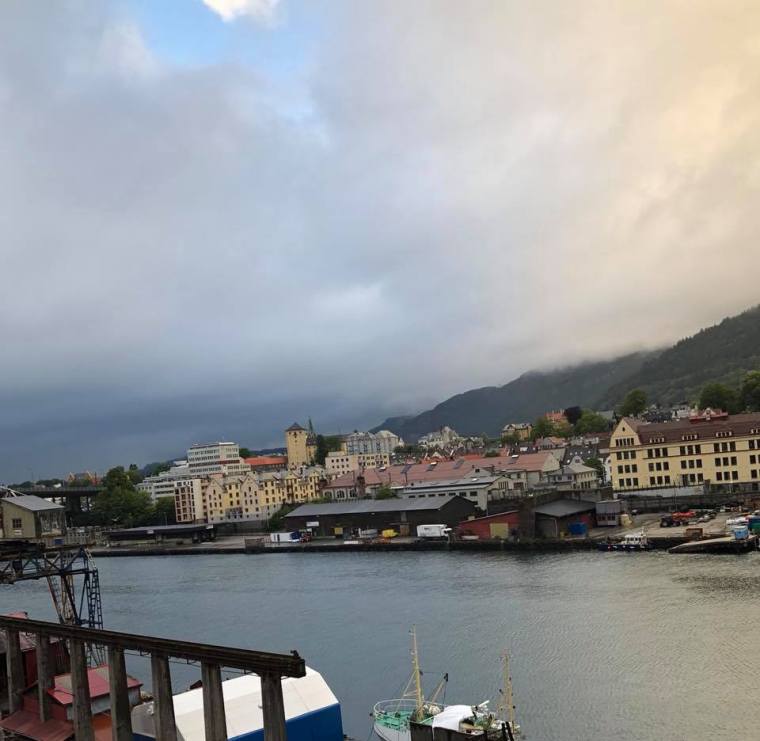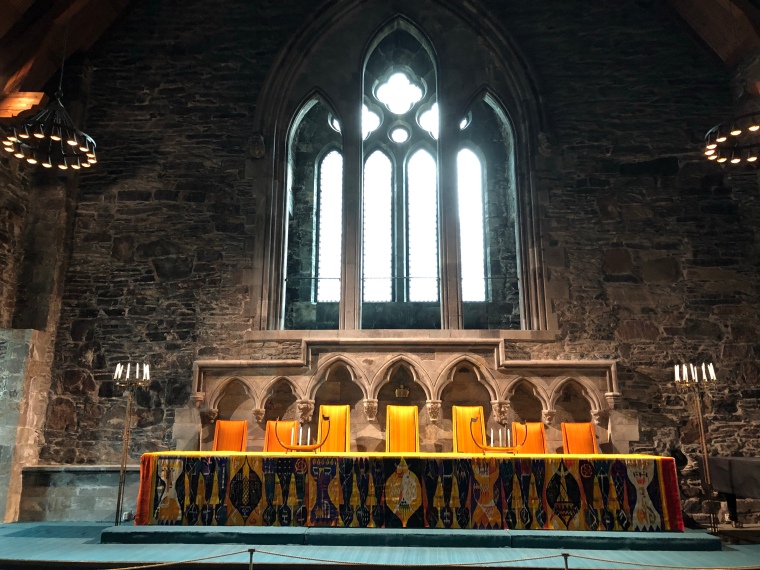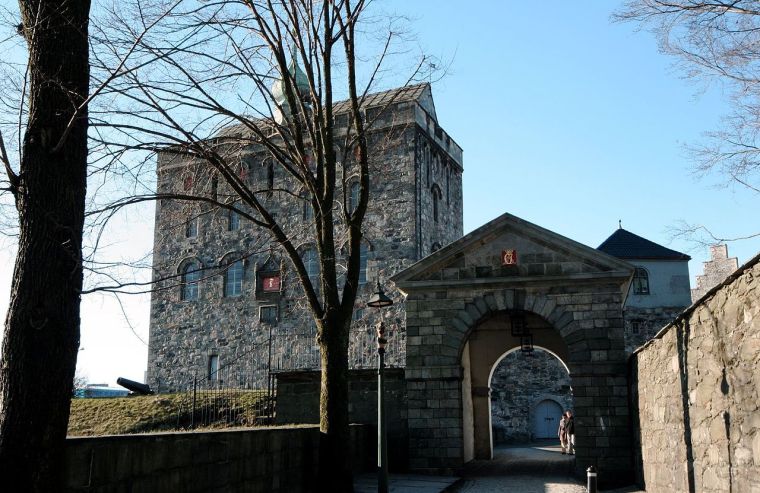So, we’ve been in Bergen about two weeks, and all I can say is, “Wow!” Over the past fourteen days, we’ve hiked Mt. Fløyen, visited Bergenhus, walked around the city centre, and learned how to navigate the grocery stores. All in all, it’s been an exciting two weeks. Today, I just want to share some pictures and stories about our time here in Bergen so far. Melissa has been sharing about our experiences as well. You can head over to Notes from Norway to see more. As well, a stuffed Aubie has tagged along with us and started his own Instagram and Twitter pages. Make sure to follow him to see his unique insights into our adventures. The other day, he somehow ended up in the dungeon at Rosenkrantztårnet. We still don’t know how that happened. 
For me, the most amazing things about my time in Bergen so far has to be the scenery and the history. We have not experienced everything Bergen has to offer, and we still need to experience the fjords, Songefjorden and Hardangerfjord specifically. In a couple of days, we’ll be heading to a fjord to fish for mackerel. There will definitely be some pics.
At times, I do not have any words to describe the natural scenery of this city. Siting in bed at 8:40 at night, I can look out over the water and see the city centre, the university and the steeple of Johanneskirken in the forefront. The sky lights up with color as the clouds drift listlessly over Mt. Fløyen towards the sea , and I seriously don’t want to work anymore. However, I must work, so I type then stare, type then stare, type then stare, until the sun eventually goes down and the city lights appear, causing me to cease work entirely.

The first weekend we were here, we decided to hike up Mt. Fløyen, the mountain we can see from our apartment. The highest point on Fløyen is 425 m (1,394 feet). We did not hike to the highest point, but we did hike to the lookout, where the funicular ends, and around to a lake on the top. While it took a while to trek up the mountain with a five year old in tow, it was worth it. The lushness of the vegetation and the rock formations caused us to take longer as well. We would stop at almost every turn in the trail to snap a picture of the flora populating the mountain.
Fløyen overlooks Bergen, and you can see all the way from the islands in the west to Mt. Ulrikne in the east. You can see Bergenhus, Johanneskirken , the university, Lille Lungegårdsvannet, and everything in between. As we hiked up Fløyen, the air, of course got colder, and it started to rain. Even with this, we took in the view and had some ice cream as we overlooked Bergen before letting the kids head over to the playground to run around and have fun. (The images below, in order, are from various stages of the hike up Fløyen. The last images are from the lookout point.)





On another day, we decided to visit Bergenhus Festning, the royal residence when Bergen was the capital of Norway. There, we toured Håkonshallen (Håkons Hall) and Rosenkrantztårnet (Rosenkrantz Tower). Both of these buildings make up part of the Bergenhus Festning. Håkonshallen dates back to the 13th century. King Håkon Håkonsson erected the hall between 1247 and 1261. During the late Middle Ages, Norway did not have a resident monarchy, so Håkonshallen became used as a store house. During the centuries, various individuals renovated the structure, and in 1944, the explosion of a German ammunition ship in the harbor damaged the structure, leaving only the walls. Håkonshallen as it stands today is a result of the restoration following the 1944 explosion. It is still used, even today, for ceremonial purposes.
In the great hall, a massive structure measuring 33 m (108.26 f) long, 13 m (42.65 f) wide, and 17 m (55.77 f) high, there is the royal high table at the far end which is adorned by a tapestry by Synnøve Anker Aurdal and along the eastern wall, Sigrun Berg‘s tapestry, “Primstaven” (The Calendar Stick) stretches for most of the hall.


After we toured Håkonshallen, we walked across the grounds to Rosenkrantztårnet, a tower erected by the governor of Bergenhus, Erik Rosenkrantz, in the 1560s. The Rosenkrantztårnet tower, according to the museum literature, joined royal residence “Holmen” with the remains of a fortified tower that King Magnus Lagabøte erected around 1270. We were unable to get pictures of the outside of the tower, but we climbed the entire structure, visiting the dungeon, King Magnus Lagabøte’s chapel, the cannon loft, the guard’s room, the bedchambers, and other rooms. The first picture below is the outside from Wikipedia. To see some picture’s of the inside of Rosenkrantztårnet, head over to Notes from Norway. One thing I will definitely remember are the stairs inside of Rosenkrantztårnet. The narrowness and steepness was incredibly disorienting at first, but we got used to it pretty quickly. (Pic of stairs below is from Notes from Norway.)


I hope you’ve enjoyed this photo-post. Over the course of the upcoming months, I will periodically share more posts like this so you can follow along with our Norwegian journey. Do you have any suggestions for sites to see around Bergen or places to go in Norway? If so, let me know in the comments below, and make sure to follow me on Twitter at @silaslapham.






Hello! It’s Julia from yesterday’s seminar group. Thank you for a great seminar – I really enjoyed it! And I’m glad I found your blog, since it provides many interesting literary and cultural insights (I’m not trying to apple-polish, I promise). Since you’re looking for recommendations for things to do in Bergen, I thought I’d mention The Hanseatic Museum. It’s the one Hanseatic building at Bryggen where the most of the interior is still preserved. It actually closes on October 1. for renovation, so I thought I’d mention it so you have a chance to see it before then. It’s best to join a guided tour, since it provides additional information about the Hanseatics life at Bryggen, and the specifics of the museum (I should also mention that I worked there this summer, so I’m not entirely objective). Another tip is the tiny Theta Museum at Bryggen. It’s a radio room used by the Norwegian resistance during WW2. It has restricted opening hours and I don’t know if it’s open during the winter, so I would check that out as soon as possible if you have the chance. Hope you’ll find these tips helpful!
LikeLike
Julia, Thanks. We’re planning to head to the Hanseatic Museum this weekend because of the closure. I thought it was closing a September 3. I would love to see the Theta Museum. We went, this last weekend, north of town looking for a WWII bunker. We didn’t have time to find it, but we plan to go back.
LikeLike
Sounds great! I’m glad you’re finding time to explore Bergen, and hope you’ll enjoy your stay here.
LikeLike
Pingback: Reflections on 2018 | Interminable Rambling
Pingback: What to Expect in 2019! | Interminable Rambling